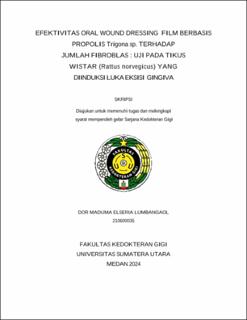Efektivitas Oral Wound Dressing Film Berbasis Propolis Trigona sp. terhadap Jumlah Fibroblas : Uji pada Tikus Wistar (Rattus norvegicus) yang Diinduksi Luka Eksisi Gingiva
Effectiveness of Propolis Trigona sp.-Based Oral Wound Dressing Film on the Number of Fibroblasts: An Experiment on Wistar Rats (Rattus norvegicus) Induced with Gingival Excision Wounds

Date
2024Author
Lumbangaol, Dor Maduma Elseria
Advisor(s)
Nasution, Rini Octavia
Metadata
Show full item recordAbstract
Gingiva is a periodontal tissue that is often injured, leading to tissue loss. One type of injury at gingiva is trauma, which is commonly experienced. Injuries to the gingiva can interfere with daily activities such as eating, speaking, and socializing. Therefore, active ingredients are needed to promote wound healing. Propolis is a product derived from bee hives that contains various active compounds, one of which is an antiinflammatory agent. Propolis is widely used in healthcare, particularly in the field of dentistry. The propolis used in this study is sourced from Geniotrigona thoracica bees native to North Sumatra. This propolis is incorporated into an oral wound dressing film (OWDF). An OWDF is a hydrophilic bioadhesive wound cover designed to prevent infection and accelerate the regeneration of damaged tissue. Currently available OWDFs only function as wound covers and do not contain active ingredients. The objective of this study was to evaluate the organoleptic changes in the oral wound dressing film based on Propolis Trigona sp. and to assess the effectiveness of the propolis-containing OWDF in increasing fibroblast numbers during the healing process of gingiva excision wounds in Wistar rats. This study is an experimental laboratory study conducted in vivo with a post-test control group design to evaluate healing by observing the fibroblast count. The sample consisted of 36 female wistar rats aged 2-3 months in healthy condition, which were treated and evaluated on days 1, 3, 5, 7, and 14. The results showed that the OWDF Propolis did not undergo any significant changes based on organoleptic observations, while the negative control sample showed color changes. The study also demonstrated that the 20% Propolis OWDF was effective in accelerating wound healing, as evidenced by the increase in the average fibroblast count on day 5 (50.50±2.121) and the significant decrease in fibroblast count on day 14 (16.50±0.707). These findings confirm that the Propolis OWDF is effective in accelerating the wound healing process.
Collections
- Undergraduate Theses [1910]
